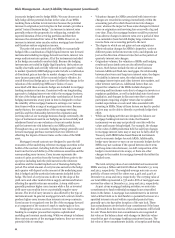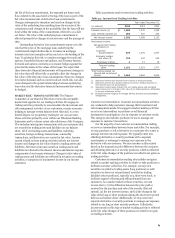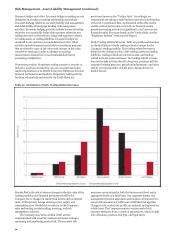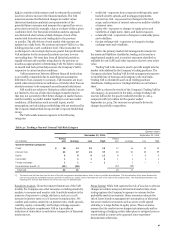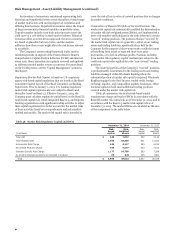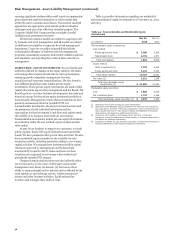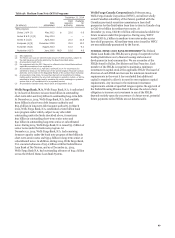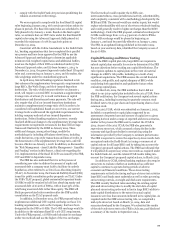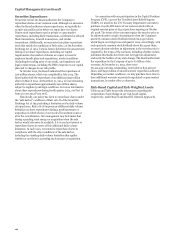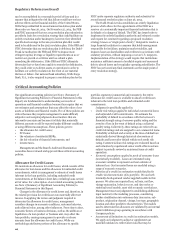Wells Fargo 2014 Annual Report Download - page 100
Download and view the complete annual report
Please find page 100 of the 2014 Wells Fargo annual report below. You can navigate through the pages in the report by either clicking on the pages listed below, or by using the keyword search tool below to find specific information within the annual report.
Risk Management - Asset/Liability Management (continued)
We access domestic and international capital markets for
long-term funding (generally greater than one year) through
issuances of registered debt securities, private placements and
asset-backed secured funding. Investors in the long-term capital
markets, as well as other market participants, generally will
consider, among other factors, a company’s debt rating in
making investment decisions. Rating agencies base their ratings
on many quantitative and qualitative factors, including capital
adequacy, liquidity, asset quality, business mix, the level and
quality of earnings, and rating agency assumptions regarding the
probability and extent of federal financial assistance or support
for certain large financial institutions. Adverse changes in these
factors could result in a reduction of our credit rating; however,
our debt securities do not contain credit rating covenants.
In light of industry changes and regulatory developments
related to the Title II Orderly Liquidation Authority of the Dodd-
Frank Act, rating agencies have proposed changes to various
aspects of their ratings methodologies. Moody’s Investors
Service has proposed significant revisions to its rating
methodology, with a focus on how each type of creditor would be
affected in any bank failure. Standard and Poor’s Ratings
Services (S&P) is continuing its reassessment of whether to
Table 57: Credit Ratings as of December 31, 2014
incorporate the likelihood of extraordinary government support
into the ratings of certain bank holding companies, including the
Parent. In addition, S&P has recently issued a proposal to
incorporate into its bank-level rating methodology an
assessment of additional capital available to absorb losses to
reduce default risk. During fourth quarter 2014, our ratings were
affirmed by Fitch Ratings and formally reviewed by S&P, with no
changes. Both the Parent and Wells Fargo Bank, N.A. remain
among the top-rated financial firms in the U.S.
See the “Risk Management – Asset/Liability Management”
and “Risk Factors” sections in this Report for additional
information regarding our credit ratings as of
December 31, 2014, and the potential impact a credit rating
downgrade would have on our liquidity and operations, as well
as Note 16 (Derivatives) to Financial Statements in this Report
for information regarding additional collateral and funding
obligations required for certain derivative instruments in the
event our credit ratings were to fall below investment grade.
The credit ratings of the Parent and Wells Fargo Bank, N.A.
as of December 31, 2014, are presented in Table 57.
Wells Fargo & Company Wells Fargo Bank, N.A.
Senior debt Short-term
borrowings Long-term
deposits Short-term
borrowings
Moody's A2 P-1 Aa3 P-1
S&P A+ A-1 AA- A-1+
Fitch, Inc. AA- F1+ AA F1+
DBRS AA R-1* AA** R-1**
* middle **high
On September 3, 2014, the FRB, OCC and FDIC issued a
final rule that implements a quantitative liquidity requirement
consistent with the liquidity coverage ratio (LCR) established by
the Basel Committee on Banking Supervision (BCBS). The rule
requires banking institutions, such as Wells Fargo, to hold
high-quality liquid assets, such as central bank reserves and
government and corporate debt that can be converted easily
and quickly into cash, in an amount equal to or greater than its
projected net cash outflows during a 30-day stress period. The
final LCR rule will be phased-in beginning January 1, 2015,
and requires full compliance with a minimum 100% LCR by
January 1, 2017. The FRB also recently finalized rules imposing
enhanced liquidity management standards on large bank
holding companies (BHC) such as Wells Fargo. We will continue
to analyze these recently finalized rules and other regulatory
proposals that may affect liquidity risk management to
determine the level of operational or compliance impact to
Wells Fargo. For additional information see the “Capital
Management” and “Regulatory Reform” sections in this Report.
Parent Under SEC rules, our Parent is classified as a “well-
known seasoned issuer,” which allows it to file a registration
statement that does not have a limit on issuance capacity. In
May 2014, the Parent filed a registration statement with the SEC
for the issuance of senior and subordinated notes, preferred
stock and other securities. The Parent’s ability to issue debt and
other securities under this registration statement is limited by
the debt issuance authority granted by the Board. The Parent is
currently authorized by the Board to issue $60 billion in
outstanding short-term debt and $170 billion in outstanding
long-term debt. At December 31, 2014, the Parent had available
$42.3 billion in short-term debt issuance authority and
$67.8 billion in long-term debt issuance authority. The Parent’s
debt issuance authority granted by the Board includes short-
term and long-term debt issued to affiliates. During 2014, the
Parent issued $18.1 billion of senior notes, of which $11.5 billion
were registered with the SEC. In addition, during 2014, the
Parent issued $4.5 billion of subordinated notes, all of which
were registered with the SEC. Additionally, in February 2015, the
Parent issued $5.2 billion of registered senior notes.
The Parent’s proceeds from securities issued were used for
general corporate purposes, and, unless otherwise specified in
the applicable prospectus or prospectus supplement, we expect
the proceeds from securities issued in the future will be used for
the same purposes. Depending on market conditions, we may
purchase our outstanding debt securities from time to time in
privately negotiated or open market transactions, by tender
offer, or otherwise.
Table 58 provides information regarding the Parent’s
medium-term note (MTN) programs. The Parent may issue
senior and subordinated debt securities under Series L & M,
Series N & O, and the European and Australian programmes.
Under Series K, the Parent may issue senior debt securities
linked to one or more indices or bearing interest at a fixed or
floating rate.
98


